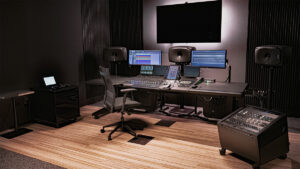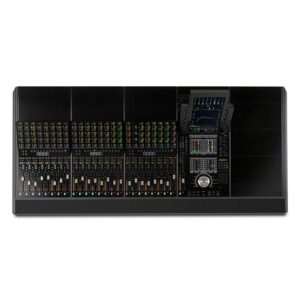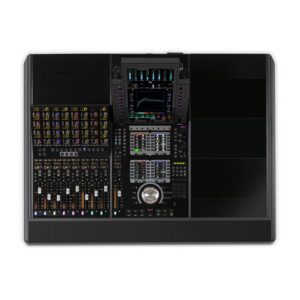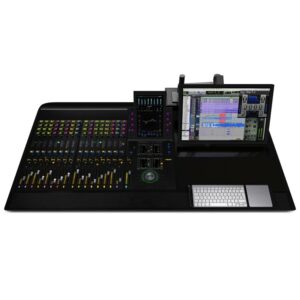
When you think of Dolby Atmos, usually what comes to mind is immersive audio files for the big screen. Using audio to create a sense of depth, and making specific scenes leap off the screen and into your ears. While Atmos is very much a tool to help film and TV come to life, audio engineers have taken to using Dolby Atmos for mixing music.
Just as it’s possible to create a spatial image using clips of audio for film, engineers can utilize these same tools to mix music. Music is no longer confined to the flat two-dimensional mixing techniques we’ve heard for decades. With Dolby Atmos opening a new path to provide more realistic and higher definition audio for music, the possibilities become limitless.
Avid makes mixing in Atmos a breeze with the Avid S4 Control Surface. We’ve teamed up with Tony Joy of Avid to showcase just how powerful mixing with Atmos and the S4 can be. Be sure to return to this page as there will be a series of videos from Tony demonstrating more groundbreaking techniques using the Avid S4 Control Surface.
Pt. 1 - Intro: Dolby Atmos Workflows on the Avid S4 with Tony Joy
Avid’s Audio Solutions Specialist, Tony Joy, introduces you to the S4 console. The Avid S4 has a semi-modular design that is ideal for independent mixers, producers, and smaller studios. Working closely with Dolby from the inception of the Atmos Format, Avid has championed immersive audio workflows. AvidPlay Distribution is a cost-effective music distribution service, allowing you to publish your work on Spotify, Amazon Music, and other platforms.
Pt 2. - Workflow Setups on the Avid S4 with Tony Joy
In this video, Avid Audio Solution Specialist Tony Joy demonstrates a production workflow on the Avid S4 console. Using a basic folder, Tony illustrates how easy it is to organize your workflow on the Avid S4 with VCAs for each section: rhythm, synthesizers, omni tracks, strings, electric guitar, and an active MIDI VCA. Watch as Tony Joy creates a VCA to group any MIDI instruments he may need for the session.
Pt. 3 - Using Pro Tools and Dolby Atmos Mastering Suite to Produce Music
In this video, Avid Audio Solution Specialist Tony Joy showcases his setup for producing music with the Avid S4. Running Pro Tools Ultimate and Dolby Atmos Mastering Suite on his laptop, Tony uses Dolby Bridge to receive audio from Pro Tools and output through the Dolby Atmos Mastering Suite.
VCA folders will help you organize your tracks more efficiently. The first eight faders on the S4 will be your VCA bank and your following eight faders are used as spill songs. When you attention any VCA, the member track spins out onto the eight faders. This allows users to create a track tailored to their workflow, giving them access to two to eight faders for VCA folders.
Tony demonstrates the simplicity of his workflow, and how he keeps everything organized – creating two separate banks; one set of eight faders for his VCA bucket and the remaining eight faders for his spill songs.
Using the rhythm VCA folder from part two of this series, Tony shows how you can access all tracks without needing to touch the Master Touch Module or the Pro Tools session. This exemplifies how the S4 makes working a breeze, with no need to reach over to your laptop since all of your tracks will be on the faders.
When working in Dolby Atmos, the S4 is ideal for panning tracks. The advantage here is there’s a lot of space to place your music. Say goodbye to left-brained work! With the Avid S4, you use muscle memory and only need to touch the faders or joystick to make music.
Avid’s S4 saves time, increases productivity, and allows you to make music that is natural and sounds amazing.
Pt. 4 - Automation on the Avid S4 with Tony Joy
The Avid S4 is powered by an internet-based protocol called EuCon, which Avid uses for all of their control surfaces. Important to note: several other Digital Audio Workstations (DAWs) support the EuCon Protocol including Pro Tools Ultimate, Logic, Cubase, and more.
In this video, Tony Joy demonstrates his use of VCAs with Automation. By hitting ‘play’, you can visualize all of the melodies in the VCA as they spill to corresponding faders. The key benefit of a VCA is that you do not need to physically move all the faders together. You can use one fader for a specific VCA. When you move one fader, all the other faders will move as the faders are linked to each track in the VCA. This feature comes in handy when you are creating a static mix.
The S4’s Automation Mode is a helpful tool to balance your mix. At the click of a button, you can mute an entire VCA section or hone in on a specific VCA and isolate an element in the melody. This incredibly useful feature is best implemented when bringing new music into a session while you’re busy writing music.
When mixing in Dolby Atmos, using Automation is crucial in making the music sound more organic. Automation also affects the panning of a track, allowing you to easily make the sound more spacious in real-time. Simply hit ‘play’ and with the use of either the joystick, knobs, or Touch Screen Module you can adjust an element’s size and placement to fit the music you’re working on. Once you let go of the board, the music will return to your static mix.
In Automation Mode, if you don’t touch the joystick, knobs, or Touch Screen Module, the mix will remain as your static mix. However, as soon as you touch one of your parameters – like panning – this brings your Atmos mix to life, giving you the ability to make your music sonically move.
With the use of the S4’s Automation, you have the ability to place your music spatially around you at your fingertips – allowing for a more realistic and lifelike result. Jump into the 4th dimension with the Avid S4, Pro Tool Ultimate, and Dolby Atmos – giving you the ability to set music free from the two speakers in front of you and flow in all directions.
Pt. 5 - Overview of the Avid S4 with Tony Joy
There are many similarities between the Avid S4 and the Avid S6. In this video, Avid Audio Solution Specialist Tony Joy describes some of the key differences between the S4 and the S6 – including the number of workstations each can support.
The Avid S4 makes collaboration with others a cinch – if you’re working with an artist that has a Cubase or Logic session on their laptop, you can easily pull over their session through your Pro Tools session onto your S4 faders.
This shows that the Avid S4 makes collaboration between two people incredibly easy and massively improves the music production workflow.
Pt. 6 - Real-Time Automation for Dynamic Mixes
The Avid S4 is so customizable that you will rarely see two people use it in the same way. Everyone’s workflow is different.
When panning in a Dolby Atmos workflow, there are a lot of parameters available to you. Some of the parameters you’ll use every time, and others may not be used very often – how you use them is entirely up to you and what’s best for your workflow.
The S4’s focus feature allows you to assign functions to specific tracks and their rotary knob. When you hit the ‘focus’ and ‘pan’ functions, for example, the track’s knobs become the panning function and the parameters become accessible on your Master Touch Module.
Another useful feature is the Expand option. By hitting the ‘Expand’ option and a specific track and then the ‘Pan’ option, the parameters fully spill over to all the knobs that are available. There are many methods that can achieve this function, it’s just a matter of what works best with your workflow. If you are a visual person, you can use the Master Touch Module to see the ‘Block’ view – or the view on the screen that looks like the knobs mapped out.
One of the functions that Tony can’t live without is the custom fader option on the Avid S4. If you hold down the ‘Expand’ button, it spills the custom parameters onto your faders. Initially, the custom fader map is empty. Use each corresponding knob to assign a desired function to each fader to build your own custom fader map.
Custom fader maps aren’t only for functions of the S4, you can actually map your favorite plugins to the faders as well. Tony shows you how you can play around with each fader and as soon as you let go of the controls, it returns to the static mix since the automation function is still active.
Tony Joy’s favorite S4 feature is having the ability to manipulate your static mix instantaneously at the touch of a knob or joystick, and once you let go of the controls it snaps back to your static mix.
Pt. 7 - Mapping External Sources on the Avid S4 with Tony Joy
In this video, Avid Audio Solution Specialist Tony Joy demonstrates how to map plugins to the Avid S4’s rotary knobs. Seeing what plugins you have available is easy, simply utilize the ‘insert’ button to scroll through your plugin library without having to look at your computer. This ability is one of the biggest advantages of the Avid S4 and S6: giving you all of the information you need at the press of a button without needing to menu dive on your computer.
Using the dynamic track with compressor plugins always assigns the threshold to the same knob, so with time, the muscle memory of using that same knob will become second nature to you.
The beauty of custom fader maps is you can expand and transfer your plugins to the custom fader map. The mapping is so intricate that you can bring in specific parameters from any of your plugins directly onto the faders.
When you use the Focus functionality, the S4 clearly shows what instruments you have mapped out in front of you.
With the Avid S4, anything is possible and can be entirely customized to your workflow. You can use the custom fader maps to bring any parameters to your fingertips, transforming the S4 into an instrument and allowing for a more natural creative environment.
Pt. 8 - Creative Control for Virtual Instruments
In this video, Avid Audio Solutions Specialist Tony Joy demonstrates how the Optional Knobs Module, Joystick Module, and Post Module on the Avid S4 can be used in a music workflow. The Post Module is generally used for a post-production workflow.
In this scenario, Tony has his MIDI tracks under a VCA called ‘MIDI’. Using the ‘Attention’ function, the S4 spills the MIDI tracks onto the Optional Knobs Module mapping the parameters based on the preferences Tony has set up on the S4. The moment Tony ‘Attentioned’ the plugin, all of the parameters of that specific set appeared on the Optional Knobs Module. You can then adjust the parameters to suit your needs using your piano keyboard.
This is useful because after you play your set, tweaking the sound becomes so simple that you can do this all with your eyes closed. Similarly, you can adjust the pan in real-time. With the Avid S4, there is no need to reach for your mouse or computer keyboard.
So why is the Post Module so important? There are two reasons: firstly, users can arm a track with the flick of a switch and edit the sound, and secondly, you can layer sounds as well. With the Post Module, you can pan-specific sounds one at a time or group them all together.
All of these functions can be done directly on the Avid S4, so you no longer need to reach for your laptop keyboard – unleashing your full creative potential. Save time with the Avid S4 and get back to focusing on what’s important: making music.
If you have any questions or would like more information on the Avid S4 feel free to reach out to us at [email protected]
Sign Up & Stay Informed When New Videos are REleased
Atmos Essentials:
-
Avid S4-24_5 SYSTEM includes 1yr ExpertPlus with Hardware Coverage
Call for PriceAdd to WishlistAlready In WishlistCall for PriceAdd to Wishlist -
Avid S4-8_3 SYSTEM includes 1yr ExpertPlus with Hardware Coverage
$24,595.00Add to WishlistAlready In WishlistAdd to cartAdd to Wishlist -
Avid S6 Modular Control Surface
Call for PriceAdd to WishlistAlready In WishlistCall for PriceAdd to Wishlist










